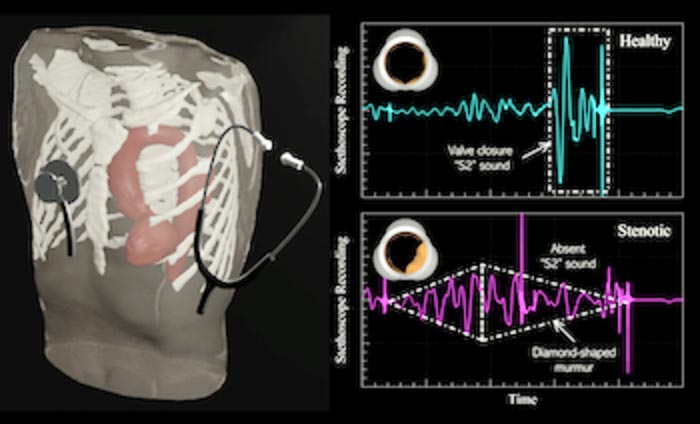Your heart 2.0

Computer simulations and machine learning can lay the groundwork for algorithms to improve diagnostic accuracy of auscultation. Research from Johns Hopkins University demonstrates how virtual stethoscope recordings from biomechanics simulations (left) can be used to develop such an algorithm, which can accurately recognize acoustic features of heart sounds from healthy (top right) and stenotic (bottom right) aortic valves. Such technology can alleviate the diagnostic subjectivity of manual auscultation and enable at-home, inexpensive self-monitoring. Credit: Shantanu Bailoor
The new science of heart health uses AI and algorithms to prevent heart attacks, strokes, and stress.
When you’re staring petrified at the new Resident Evil movie, or breathlessly following along to a vintage Jane Fonda aerobics video, what happens to your blood flow?
PhD candidate Joseph C. Muskat and a group from Purdue University created algorithms that model how healthy young adults respond to fear- and exercise-induced stress. The simulations allow scientists to probe parts of the cardiovascular system individually and measure blood pressure and flow patterns—difficult feats in living, breathing humans.
“Computer models may clarify how the human circulation evolved to increase survival or to optimize function of our muscles, organs, and nerves. The flow forces we study are known to influence vessel health and support production of hormones and organic substances, which can improve athletic performance,” said Muskat.
Two independent research teams, including Muskat’s, present new cardiovascular computer models at the 74th Annual Meeting of the APS Division of Fluid Dynamics. The research reflects a trend that promises to revolutionize heart health.
The Purdue group’s plugin for measuring flow patterns in response to fear and exercise shows how blood flow in large arteries may differ from normal expectations at rest, increasing stress on the vessel wall. All the models are publicly available.
Meanwhile, at Johns Hopkins University, fluid dynamicist Shantanu Bailoor and collaborators found a way to use artificial intelligence to detect when hearts are poised to fail completely, but long before symptoms begin to show.
“Listening to heart sounds is a valuable, centuries-old tool in the physician’s repertoire to infer heart health,” said Bailoor. “But this skill suffers from poor accuracy and has seen an unfortunate decline among clinical practitioners.”
Machine learning boosts a physician’s ability to hear the sounds of a breaking heart valve—improving diagnostic accuracy from roughly 30% to 90%, Bailoor and colleagues reported in a paper last month.
Heart disease is the leading cause of death in the United States. In particular, when replacement valves fail without warning, they can lead to heart attacks and strokes. The new computer model uses stethoscope recordings to catch mild and even asymptomatic valve problems early, without a costly and invasive angiogram.
“Further development of such technology can enable at-home patient monitoring, shifting the burden of preliminary screening for cardiovascular diseases away from hospitals, and empowering patients to maintain their independence,” said Bailoor.
Journal: Frontiers in Physiology
Article Title: Detecting Aortic Valve Anomaly From Induced Murmurs: Insights From Computational Hemodynamic Models
Article Publication Date: 6-Oct-2021
Media Contact
APS Press Office
American Physical Society
media@aps.org
Original Source
All latest news from the category: Medical Engineering
The development of medical equipment, products and technical procedures is characterized by high research and development costs in a variety of fields related to the study of human medicine.
innovations-report provides informative and stimulating reports and articles on topics ranging from imaging processes, cell and tissue techniques, optical techniques, implants, orthopedic aids, clinical and medical office equipment, dialysis systems and x-ray/radiation monitoring devices to endoscopy, ultrasound, surgical techniques, and dental materials.
Newest articles

High-energy-density aqueous battery based on halogen multi-electron transfer
Traditional non-aqueous lithium-ion batteries have a high energy density, but their safety is compromised due to the flammable organic electrolytes they utilize. Aqueous batteries use water as the solvent for…

First-ever combined heart pump and pig kidney transplant
…gives new hope to patient with terminal illness. Surgeons at NYU Langone Health performed the first-ever combined mechanical heart pump and gene-edited pig kidney transplant surgery in a 54-year-old woman…

Biophysics: Testing how well biomarkers work
LMU researchers have developed a method to determine how reliably target proteins can be labeled using super-resolution fluorescence microscopy. Modern microscopy techniques make it possible to examine the inner workings…





















